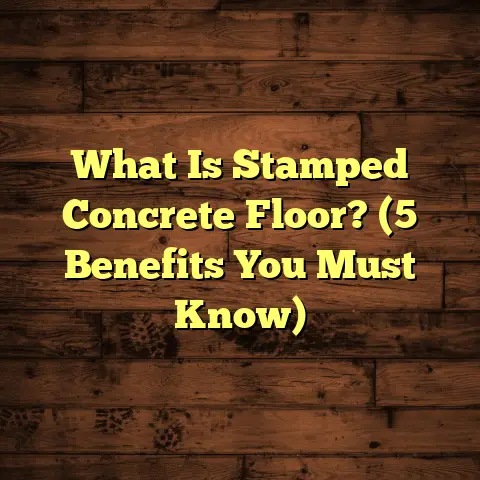What is Wear Layer of Engineered Floors? (5 Key Benefits Revealed!)
Imagine walking into a home where every step feels solid, the floor beneath your feet gleams with natural wood patterns, and you know it will stay beautiful for years—even with kids running around or pets chasing each other. That kind of flooring isn’t just about looks; it’s about lasting durability and resilience. One of the unsung heroes behind this balance of beauty and toughness is the wear layer on engineered floors. I’ve spent years installing and advising on flooring projects, and I can honestly say understanding this layer can change how you think about your floors. It’s a small part with a huge impact. Let me walk you through what exactly the wear layer is, why it matters so much, and how it stacks up against other flooring choices.
What Is the Wear Layer of Engineered Floors?
The wear layer is the very top surface of an engineered hardwood floor. Think of it as the “skin” that protects everything underneath. Unlike solid hardwood, which is one solid piece of wood throughout, engineered flooring has multiple layers—a sturdy plywood or fiberboard core topped with a thin slice of real hardwood known as the wear layer.
This layer is usually between 0.6 mm and 6 mm thick. The thickness varies based on the product quality and price range. In high-end floors, you might find a 4 mm or thicker wear layer, while budget options often come with thinner slices around 0.6 to 2 mm.
The wear layer is made from real wood species like oak, maple, hickory, or walnut. This means you get the authentic grain patterns and textures you want in hardwood flooring. But its main purpose isn’t just aesthetics—it’s about protection.
Manufacturers apply tough finishes over the wear layer to resist scratches, dents, stains, and fading caused by sunlight. These finishes often include aluminum oxide or ceramic particles embedded in polyurethane coatings, which create an incredibly durable surface.
I remember working on a downtown apartment renovation where the client wanted something that could handle heavy foot traffic but still look elegant. We selected an engineered floor with a 4 mm thick wear layer and a factory-applied aluminum oxide finish. Years later, the floor shows only minor signs of wear despite daily use from tenants coming and going.
Why Does This Matter?
The wear layer acts as a shield. It takes all the punishment from shoes, furniture, pets’ claws, and spills so the core layers below don’t get damaged or warped. Without it, your floor would be more vulnerable to scratches and moisture damage.
Thinner wear layers wear out faster because there’s less wood to protect and refinish later on. Some cheaper products only have a veneer thickness that’s not meant to be sanded or refinished at all—once damaged, the floor must be replaced.
That’s why I always advise homeowners to understand the wear layer thickness before buying engineered flooring. It’s one of those details that seem small but make all the difference over time.
The 5 Key Benefits of the Wear Layer on Engineered Floors
Let’s break down what benefits this tiny but mighty layer brings to your floor and your home life:
1. Longevity and Life Span
The first big plus is how much longer your floors can last with a thicker wear layer. Because this surface is real wood, you can sand it down when it starts looking worn or scratched—and then reapply finish coats to restore its luster.
Here’s some hard data from the National Wood Flooring Association (NWFA):
| Wear Layer Thickness | Average Number of Refinishes | Estimated Lifespan (Years) |
|---|---|---|
| 0.6 – 1.0 mm | 0 (no sanding possible) | 10-15 |
| 2 – 3 mm | 1-2 | 20-25 |
| 4 mm or more | 3-5 | 30+ |
If you want floors that can truly grow with your family—survive playground games, pet scratches, or moving furniture—a thicker wear layer is key.
I’ve had clients whose floors with 4 mm wear layers have lasted over 20 years without needing full replacement—just occasional refinishing to keep them looking fresh.
2. Scratch and Impact Resistance
How often have you seen floors get scratched by chair legs or pet claws? The finish on top of the wear layer plays a huge role in preventing this damage.
Most modern engineered floors come with factory-applied finishes that contain aluminum oxide—one of the hardest substances on Earth after diamonds. This makes the surface resistant to scratches and scuffs far better than traditional varnishes.
In one case, I installed an engineered floor in a family with three kids and two dogs. The kids were playing indoors constantly, dragging toys across the floor. After two years there were barely any visible scratches or dents thanks to a robust aluminum oxide finish on a 3 mm wear layer floor.
If you’re worried about durability but want real wood’s warmth and look, this combination is your best bet.
3. Natural Appearance and Texture
Many people prefer engineered hardwood over laminate or vinyl because it offers genuine wood aesthetics. The wear layer is what gives this authenticity.
Since it’s a real wood veneer, you can see natural grain patterns, knots, and color variations that synthetic surfaces try to copy but never quite match.
I often show clients side-by-side samples of laminate vs engineered floors so they can touch and feel the difference—the texture of a real wood wear layer is unmistakable.
Plus, finishes applied to the wear layer preserve this natural look by protecting against discoloration from UV rays or spills.
4. Refinishing Flexibility
One huge advantage engineered floors have over laminate or vinyl is that you can refinish them—if their wear layer is thick enough.
When floors start to look dull or scratched after years of use, sanding down the top finish and applying new coats restores their original beauty.
Some products with thinner wear layers (under 2 mm) don’t allow sanding without going through the veneer completely—so refinishing isn’t an option.
I’ve refinished many engineered floors with 3-4 mm wear layers during remodels, saving homeowners from costly full replacements.
5. Dimensional Stability
Engineered floors are built with multiple layers arranged crosswise beneath the wear layer to reduce movement caused by temperature and humidity changes.
This means less warping or cupping compared to solid hardwood, especially in kitchens, basements, or areas where moisture fluctuates.
The wear layer sits on top of this stable core structure, giving you hardwood beauty with better performance in challenging environments.
In one basement renovation project I did years ago, we chose engineered wood with a thick wear layer because solid hardwood wasn’t recommended due to moisture risks. The floor stayed flat and beautiful for years without problems.
My Experiences: Lessons Learned About Wear Layers
Over time I’ve picked up several lessons about how important the right wear layer choice is:
- Don’t skimp on thickness if your household is busy: Thin layers are tempting because they cost less upfront but can lead to faster replacement costs.
- Finish quality matters as much as thickness: A well-finished thin veneer can sometimes outperform a poorly finished thick one.
- Tell your installer about your lifestyle: If you have kids, pets, or heavy furniture movement, mention it—they’ll recommend appropriate products.
- Trust factory-applied finishes: They tend to be more durable than those applied on-site.
- Consider future refinishing: If resale value matters to you, thicker layers add appeal since buyers know they can renew the floors later.
Breaking Down Wear Layer Thicknesses: What Works Best?
Since thickness matters so much for durability and life span, here’s a detailed look at common wear layer ranges:
| Thickness (mm) | Typical Use Case | Pros | Cons |
|---|---|---|---|
| <1 mm | Budget options | Low cost | No sanding/refinishing possible |
| 1-2 mm | Light residential use | Affordable; some durability | Limited sanding; wears faster |
| 2-3 mm | Moderate residential/commercial | Can be sanded once or twice | Higher cost than thinner veneers |
| 3-4 mm | High-traffic homes/offices | Durable; multiple sanding cycles possible | Higher initial investment |
| >4 mm | Premium floors | Longest lifespan; refinishing multiple times | Most expensive |
I always advise clients who want lasting floors to aim for at least 3 mm thickness for their wear layer unless budget is an issue.
How Does the Wear Layer Affect Installation?
While most focus on aesthetics and durability when choosing wear layers, installation considerations also matter:
- Thicker wear layers add slight weight: This usually isn’t noticeable but can affect shipping costs.
- Sanding after installation: Floors with thicker wear layers are often sanded onsite after installation for a seamless finish.
- Subfloor preparation: Engineered floors require flat subfloors regardless of wear layer thickness.
- Installation methods vary: Floating vs glue-down vs nail-down methods don’t depend heavily on wear layer but on core construction.
When I install floors with thicker wear layers intended for refinishing later, I take extra care during installation because those floors represent a bigger investment for clients.
Maintenance Tips Specific to Wear Layers
To keep your engineered floor’s wear layer looking great:
- Use furniture pads: Prevent scratches from moving chairs or tables.
- Sweep regularly: Dirt and grit act like sandpaper on your finish.
- Avoid harsh cleaners: Use pH-neutral products designed for hardwood.
- Control humidity: Keep indoor humidity between 35%-55% to avoid wood expanding or contracting.
- Refinish when needed: Don’t wait until damage worsens; light sanding restores surfaces well before issues become permanent.
I often tell clients that treating their floor like a fine piece of furniture pays off long term.
Real Case Study: Wear Layer Impact on Family Home Flooring
Let me share a real example from my work:
A couple with two young kids wanted durable floors that looked modern but could handle spills and heavy foot traffic in their open-plan living room. We selected engineered oak flooring with a 3.5 mm wear layer finished with aluminum oxide coating.
After four years, they reported minimal scratches despite daily activity including dog paws and kids’ toys being dragged around. When we inspected during their kitchen remodel, the floor still looked vibrant with only minor dullness in some spots—easily fixed by refinishing later if desired.
This case confirmed what I’ve seen many times: investing upfront in a thicker wear layer pays dividends in durability and appearance retention.
How I Use FloorTally to Estimate Costs for Different Wear Layers
Budgeting flooring projects can be tricky since material quality varies widely. I rely on tools like FloorTally for quick, accurate cost estimates tailored to specific materials including variations in wear layer thicknesses.
When planning projects:
- I input room dimensions.
- Select the exact engineered floor model including its wear layer thickness.
- Factor in local labor costs and waste percentages.
- FloorTally generates detailed cost breakdowns showing how upgrading from a 1 mm to a 3 mm wear layer affects total price.
This helps me be transparent with clients about trade-offs between initial costs and long-term value without guessing or overpromising.
Comparing Engineered Floors’ Wear Layers With Other Flooring Solutions
It helps to compare engineered floors’ wear layers against alternatives:
Solid Hardwood Floors
Solid hardwood is one big piece of wood throughout—usually around 19 mm thick—and can be sanded multiple times (up to 8 times depending on thickness).
Pros:
- Long lifespan if cared for.
- Can be refinished many times.
Cons:
- More prone to moisture-related warping.
- Usually more expensive upfront.
Engineered floors’ thinner wear layers limit sanding cycles but offer superior moisture resistance thanks to layered construction beneath.
Laminate Flooring
Laminate has no real wood on top—just photographic images covered by a resin-based protective layer (usually melamine).
Pros:
- Lower cost.
- Good scratch resistance.
Cons:
- Cannot be refinished.
- Artificial look/feel compared to real wood.
Wear layers on laminate are synthetic coatings—not real wood—and once damaged you must replace planks entirely.
Vinyl Plank Flooring
Vinyl planks mimic wood but are plastic-based materials topped with printed designs sealed under clear coatings.
Pros:
- Waterproof.
- Affordable.
Cons:
- No real wood feel.
- Not refinishable or repairable easily.
Engineered wood’s real wear layer offers greater authenticity and repair options than vinyl alternatives.
When I weigh all these options for clients wanting hardwood looks combined with durability, engineered floors with quality wear layers strike a perfect balance between beauty and practicality.
Choosing your flooring shouldn’tYour request failed. Please try again.





